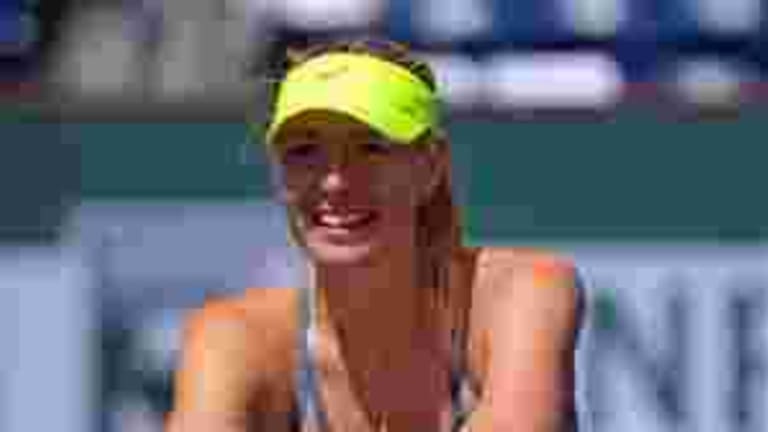Sure, every player has days like Maria Sharapova experienced today in the Indian Wells final, when it appeared that she could do no wrong. It makes up for those days when a player doesn’t feel like he or she can do anything right.
But as Sharapova pounded No. 8 seed Caroline Wozniacki in an hour and 21 minutes, 6-2, 6-2, it was tempting to interpret the win as representing something more permanent than a hot hand. It looked like the fruit of the many long hours spent working to improve an always dangerous but often shaky game, combined with an unparalleled zest for competition, by perhaps the hardest working woman in tennis.
It would be easier to downplay Sharapova’s win if this tournament were anything less than one of the select WTA Premier Mandatory events. And the only caveat you can attach is that since Serena Williams boycotts this event, Sharapova wasn’t impelled to face to her nemesis. I’ll bet Sharapova would love to bring the game she played today to her next battle with Williams. Given that the 26-year-old Russian has set winning Wimbledon as one of her two goals this year (the other being a title at the U.S Open), there’s a good chance that she’ll get a chance to do just that in a few months time.
Today, Sharapova demonstrated how her forehand, after a lot of custom work (performed by her coach, Thomas Hogstedt), has become a reliable as well as a lethal weapon. At one time, Sharapova seemed more inclined to run around the forehand than the backhand, but against Wozniacki she seemed happy to overplay slightly to that backhand side, giving her ample opportunities to hit the inside-out forehand.
And slowly but surely, Sharapova seems to be overcoming her adventures in erratic serving. She converted just 52 percent of her first serves, but instead of double faults, her second serve dished out unreturnables and penetrating deliveries. It that allowed her to win a whopping 70 percent of those second-serve points (14 for 20).
Given that Sharapova has a meat-and-potatoes game, these two areas of improvement represent a large portion of her game. This was Sharapova doing what she does best, and most comfortably, so there’s no reason she shouldn’t be able to do it more often.
Okay, a skeptic can question the quality of her opponent today. Wozniacki, who hit just two winners to Sharapova’s 33, took a walkover over top-seeded Victoria Azarenka to reach the semis, where she put forth an inspiring and promising comeback against Angelique Kerber. But Wozniacki is precisely the kind of player who is a danger to Sharapova because she knows how to keep the ball in play, and runs down more balls than anyone expects because her anticipation is excellent.
Wozniacki, like Sharapova, is a former Indian Wells champ. Plus, she was the No. 1 player for 67 weeks, far longer than Sharapova’s reign at the top, even though Sharapova has four Grand Slam titles and Wozniacki has none. It’s tempting to think that Wozniacki just couldn’t handle the pressure, now that she’s struggling to improve on her No. 10 ranking, but that wasn’t the case. She played her game pretty well today, but instead of forcing Sharapova to make errors by extending the rallies and keeping points alive, she looked rather like a ball machine employed by her opponent in one of those “learn to put it away” drills.
It didn’t help Wozniacki that she had a terrible start. She was broken at love in the very first game, and didn’t get a whiff of a break point until she was two breaks down and Sharapova was trying to serve out the first set.
Wozniacki didn’t learn much from her slow start. She was also broken to start the second set, and then again at precisely the same juncture as in the previous set. The last three points of that final break in the match, which put down Wozniacki 2-5, were telling. Each one was a Wozniacki error off a penetrating service return blasted right at her feet.
After the first of those errors, I jotted, “Wozniacki better serve harder or react quicker.” But she wasn’t capable of doing either. Overall, the match reminded us that a patient, clever, all-defense game may get you into the Top 10, but it’s not going to cut it in the long term against the cream of the WTA crop.
At 26, Sharapova is still young enough to enjoy a golden age, and that means 31-year old Serena, along with the younger Azarenka, had better watch their backs.

